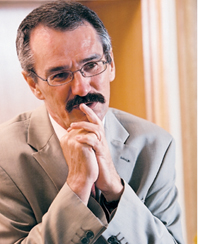 |
 |
 |
 |
 |
 |
 |
 |
 |
 |
 |
 |
 |
 |
 |
 |
 |
 |
 |
| |
In HKIEd's Annual Report last year, the President
reviewed the year through a friendly "Dialogue"
with the editorial team. The format received such
positive feedback that the editorial team once
again decided to conduct an in-depth interview
with the President. |
| |
|
|
 |
 |
 |
| Q: |
How would you describe
2004-2005? |
| A: |
It has
been an important year for HKIEd. During
this time, we saw a number of milestone
developments on the academic front while
several critical organisational issues were
also tackled.
These academic developments include:
|
| The
critical and on-going processes
to both upgrade and diversify the
range of programmes we offer. |
|
The
new academic structure which came
into effect from September 2005
to better reflect our self-accrediting
status. |
|
The
spearheading of in-depth collaboration
with the Chinese University of Hong
Kong (CUHK), which I will elaborate
on a little later. |
First of all, let me talk about our programmes.
In 2004-05, we made considerable headway
with the introduction of the Institute's
first Master of Education and our full-time
Bachelor of Early Childhood Education Programmes
in Hong Kong. The former marks a significant
milestone in our development - in line with
other universities in Hong Kong, we have
moved beyond simply offering undergraduate
programmes. This diversification not only
enriches our academic programmes, it also
enables the Institute to better meet the
different and rapidly changing needs, brought
about by the education reforms, of teachers.
Secondly, the academic structure. In order
that we can respond more quickly to new
and changing demands from the community,
we have reduced the number of decision-making
centres and layers of line management so
that policies and changes can now be formulated
more readily and efficiently. Under our
wellaligned structure, the Institute will
operate like other universities, with major
academic and research developments being
coordinated at the Institute level and implementation
taking place at the Faculty and Department
levels. During the year, we also began preparing
a five-year strategic plan for the Institute,
consulting staff, students and key stakeholders
in the process.
|
| Q: |
Why did HKIEd enter
into collaboration with CUHK? |
| A: |
Both HKIEd and CUHK
possess strengths that are complementary.
By entering into collaboration, both institutions
will strengthen their abilities to provide
the highest quality teacher education, especially
for secondary school teachers, for the community.
Students will benefit by being able to gain
the relevant subject knowledge at CUHK while
receiving their professional training at
HKIEd, and eventually earning a joint degree
from both institutions. Another positive
outcome of the collaboration is that it
will strengthen research capacities at both
institutions, in addition to also expediting
the introduction of research post-graduate
student supervision at HKIEd.
|
|
|
 |
 |
 |
 |
| Q: |
Can you
talk about the teacher demand and supply
situation? What can Hong Kong do about it
and how can HKIEd attract additional students? |
| A: |
Over the
past few years, there have been widely-held
views that there would be massive teacher
redundancies with new teachers remaining
unemployed because of the declining birth
rate. In stark contrast to these forecasts,
our graduates have enjoyed high employment
rates, coupled with very positive feedback
from their employers. In Hong Kong, the
demand for teachers is not merely driven
by changes in the school age population,
it is also strongly influenced by government
policies and initiatives. These include:
the introduction of the specialist subject
teacher scheme, the Voluntary Departure
Scheme for serving teachers, and the one-line
budget system which has provided greater
flexibility in teacher employment. Consequently,
we are now seeing a renewed demand for primary
school teachers. Unfortunately, to meet
this need, a number of schools have once
again begun employing untrained teachers.
This is worrying as it can undermine the
recent education reforms, which require
top quality and professionally trained teachers.
Further exacerbating the perception that
there is an over-supply of teachers, is
the declining attractiveness of teaching
as a profession. In recent years, teacher
education institutions have found it difficult
to attract the top level of secondary school
leavers into the teaching profession. The
community should therefore consider adopting
the strategies which have been successfully
used elsewhere to attract young people into
the profession. These include awarding scholarships,
waiving tuition fees for students of teacher
education and paying students during their
teaching practice periods.
|
|
|
 |
 |
|
 |
 |
 |
 |
 |
| |
 |
| |
At HKIEd, apart from the Joint University
Programmes Admission Scheme (JUPAS),
we are increasingly attracting students
through non-JUPAS channels and through
international recruitment drives -
last year for example, the number
of non-JUPAS entrants doubled. The
diverse backgrounds of non-JUPAS entrants,
who have worked as social workers,
air-hostesses, businessmen, bank clerks
and lawyers in their previous jobs,
also provide an invaluable asset in
their teaching careers.
The recruitment of international students
is another area where we have broadened
our profile. Currently the majority
of our international students come
from the mainland and from countries
such as Australia and Ghana in West
Africa. Our diverse range of exchange
programmes, student visits and immersion
programmes also provides our students
with an opportunity to broaden their
horizons. Students returning from
these experiences are more adaptable,
culturally aware and receptive to
new ideas. This diversity enriches
and enhances life on campus. |
|
|
|
|
 |
 |
 |
|
 |
 |
 |
 |
|
|
 |
 |
|
 |